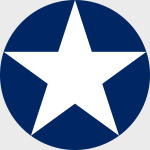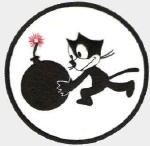Hobby Master HA8908 US Navy Grumman F4F-4 Wildcat Fighter - "White 11", Lt. Scott McCuskey, VF-3, USS Yorktown (CV-10), June 1942 (1:48 Scale)
"Skipper, it really worked. I couldn't make any attack without seeing the nose of one of your airplanes pointed at me."
- Ensign Edward "Butch" O'Hare discussing the newly-developed "Thach Weave" maneuver with Lt. Commander John Thach
 The Grumman F4F Wildcat was the standard carrier-based fighter of the United States Navy for the first year and a half of World War II. An improved version built by General Motors (the General Motors FM Wildcat) remained in service throughout the war, on escort carriers where newer, larger and heavier fighters could not be used.
The Grumman F4F Wildcat was the standard carrier-based fighter of the United States Navy for the first year and a half of World War II. An improved version built by General Motors (the General Motors FM Wildcat) remained in service throughout the war, on escort carriers where newer, larger and heavier fighters could not be used.
The Wildcat was outperformed by the Mitsubishi Zero, its major opponent in the Pacific war, but held its own by absorbing far more damage and wielding more firepower. With heavy armor and self-sealing fuel tanks, the Grumman airframe could survive far more than its lightweight, unarmored Japanese rival.
The original Grumman F4F-1 design was a biplane, which when proving inferior to rival designs was recast as the monoplane F4F-2. This was still not competitive with the Brewster F2A Buffalo which won initial US Navy orders, but when the F4F was fitted with a more powerful engine, the Pratt & Whitney Twin Wasp, it showed its true merits and became the F4F-3. US Navy orders followed as did some (with Wright Cyclone engines) from France; these ended up with the Royal Navy's Fleet Air Arm after the fall of France. In British service initially these were known as the Martlet I, but not all Martlets would be to the exact same specifications as US Navy aircraft. The F4F-3A would enter service as the Martlet III(B), the FM-1 as the Martlet V, and the FM-2 as the Martlet VI. The name Wildcat was still commonly used for these aircraft in spite of the official name change.
A new version, the F4F-4, entered service in 1942 with six guns and folding wings, allowing more to be crammed on a carrier; this was the definitive version and the one that saw the most combat service in the early war years including the Battle of Midway.
Grumman production ceased in early 1943 to make way for the newer F6F Hellcat, but General Motors continued producing them for both US Navy and Fleet Air Arm use, as larger fighters such as the Hellcat and the Vought F4U Corsair were too large for use on escort carriers. At first they produced the identical FM-1 model but then switched to the improved FM-2 (based on Grumman's F4F-8 prototype) with a more powerful engine and a taller tail to cope with the torque. In all, 7,251 Wildcats were built.
All versions of the Wildcat used hand-cranked landing gear with a relatively narrow track, making landing accidents where the landing gear were not fully locked into place distressingly common.
Pictured here is a 1:48 scale US Navy Grumman F4F-4 Wildcat fighter that was piloted by Lt. Elbert "Scott" McCuskey, who was attached to VF-3, then embarked upon the USS Yorktown (CV-10), during June 1942.
Pre-order! Ship Date: August 2024.
Dimensions:
Wingspan: 9-1/2-inches
Length: 7-1/4-inches
Release Date: ?
 Historical Account: "Prelude to Midway" - On May 4th, 1942, Yorktown took part in the operation against the Imperial Japanese Navy's (IJN) Invasion of Tulagi in the Solomon Islands. McCuskey flew an afternoon patrol over the Florida Islands, where he and his division of four Grumman F4F Wildcats (led by Lieutenant(jg) Bill Leonard) strafed a beached Japanese minesweeper near Tulagi and the destroyer Yuzuki heading towards Savo Island. This resulted in the death of the destroyer's captain and several of the ship's crew. On the return flight, McCuskey and his wingman, Ensign John P. Adams, got separated from the rest of the division and were forced to land on a beach on the south-east part of Guadalcanal. They were helped by the natives before the destroyer Hammann picked them up. As a result of getting lost and ditching at Guadalcanal, he was grounded for two days by the squadron commander. This prevented him from flying the evening mission of May 7th with Lieutenant Commander James Flatley that intercepted the IJN strike force (despite him begging to go).
Historical Account: "Prelude to Midway" - On May 4th, 1942, Yorktown took part in the operation against the Imperial Japanese Navy's (IJN) Invasion of Tulagi in the Solomon Islands. McCuskey flew an afternoon patrol over the Florida Islands, where he and his division of four Grumman F4F Wildcats (led by Lieutenant(jg) Bill Leonard) strafed a beached Japanese minesweeper near Tulagi and the destroyer Yuzuki heading towards Savo Island. This resulted in the death of the destroyer's captain and several of the ship's crew. On the return flight, McCuskey and his wingman, Ensign John P. Adams, got separated from the rest of the division and were forced to land on a beach on the south-east part of Guadalcanal. They were helped by the natives before the destroyer Hammann picked them up. As a result of getting lost and ditching at Guadalcanal, he was grounded for two days by the squadron commander. This prevented him from flying the evening mission of May 7th with Lieutenant Commander James Flatley that intercepted the IJN strike force (despite him begging to go).
On May 8th, McCuskey was restored to duty and flew escort for the USN strike force against the IJN carriers Shōkaku and Zuikaku. During the mission, his division was attacked by two Mitsubishi A6M Zero fighters, one of which he managed to shoot down. Afterwards, three more Combat Air Patrol (CAP) Zeros attacked the Douglas TBD Devastators that McCuskey's division was protecting. One of them, most likely Petty Officer Sadamu Komachi, chased McCuskey into a cloud, and out of the fight. However, the escorting Wildcats successfully protected the torpedo bombers, as none were lost during the attack on Shōkaku. Near the enemy carriers, McCuskey encountered two more Zeros and escaped by diving into a rain squall. He returned to the US fleet and landed on the damaged Lexington, as he could not locate Yorktown. Lexington later sank with his Wildcat fighter on board. After the battle, he returned to Yorktown, and VF-42 was merged into VF-3, which was commanded by Lieutenant Commander John Thach.


